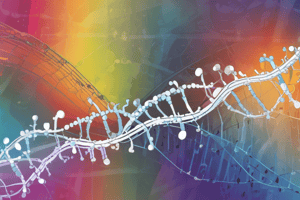Podcast
Questions and Answers
MRNA is made during (transcription/translation).
MRNA is made during (transcription/translation).
- Transcription (correct)
- Translation
MRNA is made in the (cytoplasm/nucleus).
MRNA is made in the (cytoplasm/nucleus).
- Cytoplasm
- Nucleus (correct)
DNA is located in the (nucleus/cytoplasm).
DNA is located in the (nucleus/cytoplasm).
- Nucleus (correct)
- Cytoplasm
(mRNA/tRNA) is used to carry the genetic code from DNA to the ribosomes.
(mRNA/tRNA) is used to carry the genetic code from DNA to the ribosomes.
(DNA/RNA) has a deoxyribose sugar.
(DNA/RNA) has a deoxyribose sugar.
(DNA/RNA) uses uracil instead of thymine.
(DNA/RNA) uses uracil instead of thymine.
(RNA/amino acids) make up a protein.
(RNA/amino acids) make up a protein.
Transcription takes place in the (nucleus/cytoplasm).
Transcription takes place in the (nucleus/cytoplasm).
TRNA is used in (translation/transcription).
TRNA is used in (translation/transcription).
TRNA has (anticodons/codons) that are complementary to mRNA.
TRNA has (anticodons/codons) that are complementary to mRNA.
Proteins are made at the (nucleus/ribosome).
Proteins are made at the (nucleus/ribosome).
(tRNA/mRNA) carries the amino acids.
(tRNA/mRNA) carries the amino acids.
TRNA is found in the (nucleus/cytoplasm).
TRNA is found in the (nucleus/cytoplasm).
(Translation/Transcription) converts mRNA into a protein.
(Translation/Transcription) converts mRNA into a protein.
Translation takes place in the (cytoplasm/nucleus).
Translation takes place in the (cytoplasm/nucleus).
(DNA/RNA) can leave the nucleus.
(DNA/RNA) can leave the nucleus.
(Translation/Transcription) converts DNA into mRNA.
(Translation/Transcription) converts DNA into mRNA.
Flashcards are hidden until you start studying
Study Notes
Transcription and Translation Overview
- mRNA is synthesized during transcription, which occurs in the nucleus of a cell.
- DNA is also located in the nucleus, serving as the template for mRNA synthesis.
Role of RNA
- mRNA (messenger RNA) carries the genetic code from DNA to ribosomes for protein synthesis.
- tRNA (transfer RNA) plays a crucial role in translation, bringing amino acids to the ribosomes.
Chemical Differences
- DNA contains deoxyribose sugar and utilizes thymine; in contrast, RNA features ribose sugar and replaces thymine with uracil.
Protein Synthesis Process
- Proteins are assembled at the ribosome, where translation converts mRNA into a functional protein.
- tRNA has anticodons that pair with corresponding codons on mRNA, ensuring the correct amino acids are added.
Location of Processes
- Transcription occurs in the nucleus, while translation takes place in the cytoplasm.
- Unlike DNA, RNA is capable of exiting the nucleus to participate in the protein synthesis process.
Key Components
- Amino acids are the building blocks of proteins, which are formed during translation.
- tRNA is essential in transporting amino acids to the ribosome, enabling the assembly of proteins based on the mRNA template.
Studying That Suits You
Use AI to generate personalized quizzes and flashcards to suit your learning preferences.




